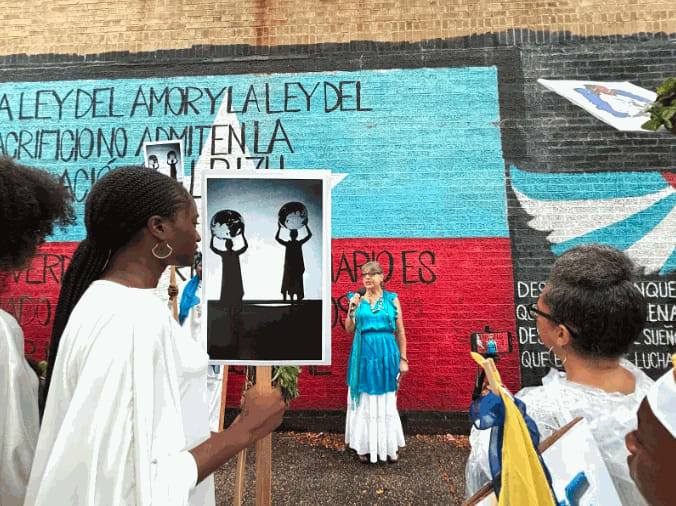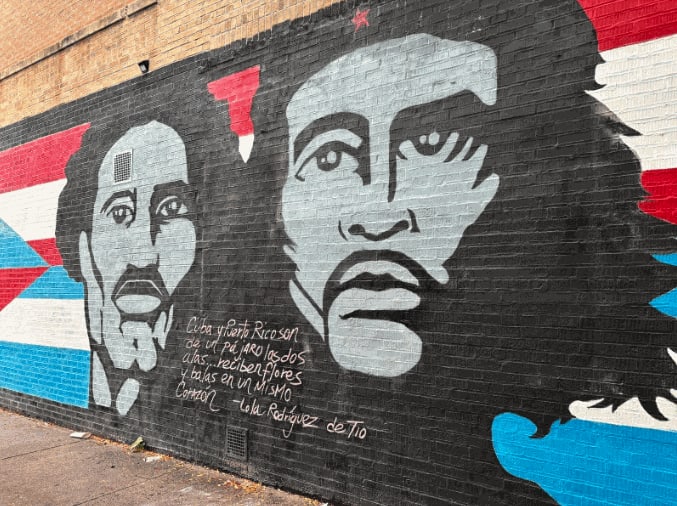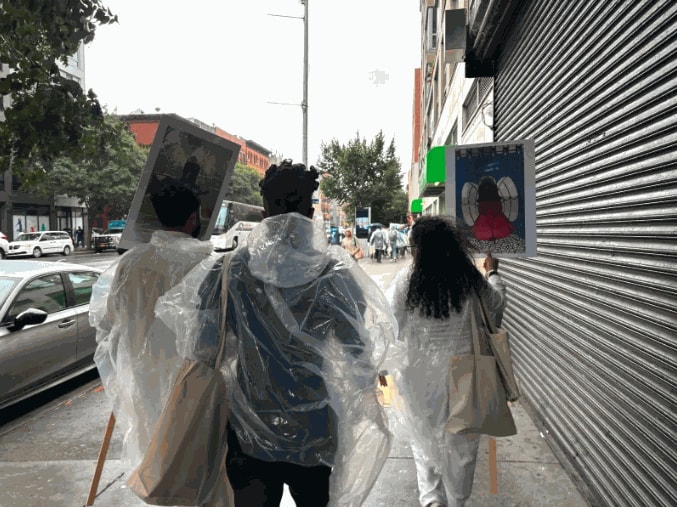15 September 2024
Around noon on Saturday, September 7, I found myself in a nondescript classroom at El Museo del Barrio giddily singing Happy Birthday to Oshun and Yemayá, two orishas of the Yoruba religion, before a pair of towering cakes generously iced in their respective hues of yellow-gold and blue and white.
This was the conclusion of María Magdalena Campos-Pons’s first “Procession of Angels for Radical Love and Unity,” a two-part walking performance this month in which she leads artists, musicians, and members of the public to sites across Manhattan that hold special meaning for Black, Cuban, and Cuban-American New Yorkers. Starting bright and early at Harlem Art Park on East 120th Street, we made our way downtown to the “Dos Alas” mural on 105th, and then westward to El Museo, a phalanx of white, blue, and yellow (per the artist’s request) beneath transparent rain ponchos.
Almost exactly a year ago, Campos-Pons and a group of performers dressed in an identical palette and filled the atrium of the Brooklyn Museum for “A Mother’s River of Tears,” a piece that drew upon Yoruba healing practices and ancestral rituals to commemorate Black individuals killed by racist violence. It involved many of the same themes as “Procession of Angels,” entwining movement, sound, and sensorial elements to arouse a catharsis of sorrow and joy. But the cavernous acoustics of the museum’s Beaux-Arts Court, and a format that limited audience engagement, inhibited the work’s potential. By contrast, the recent performance in East Harlem, a collaboration with the Madison Square Park Conservancy, captured the essence of Campos-Pons’s practice. Her excellence as an artist lies in making room for others; in harnessing the collective toward a unified vision that inspires exaltation.
As lazy gray clouds settled above us at Harlem Art Park, the rhythms of Afro-Cuban vocal and drum ensemble Belongó shook any remnants of sleep from our bodies. Performers danced in the center of the circle that formed around them and Campos-Pons joined with bundles of mint leaves and sunflowers in honor of Yemayá, who presides over the oceans and waters, and Oshun, goddess of love and fertility. (These figures reappear throughout Campos-Pons’s oeuvre in part because her paternal grandmother, a Santería priestess, assigned them as the artist’s guardian orisha deities days after her birth.)
In an address to the crowd, she shared a memory of breaking down into tears when she saw the Sistine Chapel for the first time. Just as the chapel was Michelangelo’s studio, she said, “I invite you to make the streets of East Harlem yours.”
“I am not comparing myself to Michelangelo, and you don’t need to cry,” she clarified.
After a ceremony that included poems by Ricardo Blanco, approximately 120 of us began the pilgrimage to our first stop, first gingerly and soon with the buoyant confidence needed to skirt pedestrians and stop traffic in the stirring city morning. Soon we were standing before the imposing “Dos Alas” (“Two Wings”) mural, portraying Ernesto “Che” Guevara and Pedro Albizu Campos, and named after Lola Rodríguez de Tió’s metaphor of Cuba and Puerto Rico as “two wings of the same bird.”
Albizu Campos was the leader of the Puerto Rican independence movement; Guevara the ubiquitous face of the Cuban Revolution, remembered as an anti-capitalist hero by some and a cold-blooded killer by others. Painted in 1997 by mostly Puerto Rican artists fighting against gentrification in El Barrio, the mural “stood untouched until a few years ago, when people who decided they didn’t like Che Guevara began vandalizing it,” Nuyorican documentarian and poet Marina Ortiz told us. “And each year we come and restore it.”
Campos-Pons was raised in the Cuban province of Matanzas. She was born in 1959, the year of Fidel Castro’s rise to power, in the former barracks of the sugar plantation where her Nigerian great-grandfather was enslaved. Constrained by the repression of artistic freedom on the island, she experienced other limitations once she relocated to the United States, where a strict travel and trade embargo kept her isolated from her family. This sense of “self-exile,” writes Carmen Hermo, who curated the exhibition at the Brooklyn Museum last year, in that show’s catalogue, evidently influenced the artist’s perspective — one already complicated by her ancestral ties to colonial violence.












